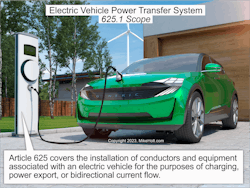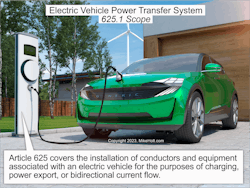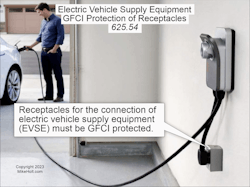Electric vehicles (EVs) have been around for a long time. Factories and warehouses often use electric lift trucks, and, of course, there’s the familiar golf cart. These and other off-road vehicles have charging requirements that are easily accommodated by small charging systems.
Now a new challenge is increasingly common: the electrically powered passenger car, truck, bus, or motorcycle. Such vehicles, especially an electric car or bus, can weigh considerably more than a golf cart, so just moving one takes a proportionately larger drive motor. Some have multiple drive motors.
Those motors are powered by batteries. Adding to the battery sizing requirement are other demands. For example, these vehicles:
- Must be able to travel at highway speeds over distances comparable to those traveled by their internal combustion engine counterparts.
- Have powered accessories that you typically don’t find on a golf cart, such as air conditioning, electric windows, stereo systems, windshield wipers, security systems, and window defrosters.
- Are expected to start in the summer heat and in the brutal winter cold.
Consequently, the conductors must be sized to be protected by the circuit overcurrent protective device per Sec. 240.4, including Sec. 110.14(C)(1) considerations, plus Sec. 310.16.
The power transfer equipment must have a sufficient rating to supply the load served. The NEC considers EV charging loads to be continuous loads. Services and feeders must be sized per the product ratings [Sec. 625.42]. Where an automatic load management system is used, the maximum equipment load on a service and feeder is the maximum load permitted by the automatic load management system [Sec. 625.42(A)].
Adjustable settings are allowed only on fixed-in-place equipment. If adjustments affect the rating label, those changes must be per the manufacturer’s instructions, and the adjusted rating must appear on a label with sufficient durability to withstand the environment [Sec. 625.42(B)].
EV supply equipment with restricted access to an ampere adjusting means can have an ampere rating(s) equal to the adjusted current setting. Sizing the service and feeder to match the adjusting means is allowed.
Restricted access must prevent the user from gaining access to the adjusting means. Restricted access must be accomplished by one of the following:
(1) A cover or door that requires the use of a tool to open.
(2) Locked doors accessible only to qualified personnel.
(3) Password-protected commissioning software accessible only to qualified personnel.
EV equipment rated more than 60A or over 150V to ground must have a readily accessible disconnect capable of being locked in the open position with provisions for locking to remain in place whether the lock is installed or not [Sec. 625.43, 110.25].
Equipment connection rules depend upon whether the EV equipment is:
- Portable. Use one of the four methods in Sec. 625.44(A). It’s going to be some type of non-locking, 2-pole receptacle.
- Fastened-in-place. Use one of the four methods in Sec. 625.44(B). It’s going to be some type of non-locking, 2-pole or 3-pole receptacle.
- Fixed-in-place. Permanently wire it in.
EVSE that incorporates a power export function and is part of an interactive, optional standby system or electric power production source or a bidirectional power feed must be listed and marked as suitable for that purpose [Sec. 625.48]. When used as an optional standby system, the requirements of Art. 702 apply; when used as an electric power production source, the requirements of Art. 705 apply.
Locate EVSE to permit direct electrical coupling of the EV connector to the EV [Sec. 625.50].
Unless specifically listed and marked otherwise, the coupling means of the EVSE must be at least 18 in. above the floor for indoor locations and at least 24 in. above grade for outdoor locations.
Mechanical ventilation is not required where the EV supply equipment is listed for charging EVs indoors without ventilation [Sec. 625.52(A)].
Mechanical ventilation is required where the EV supply equipment is listed for charging EVs with ventilation for indoor charging [Sec. 625.52(B)]. The ventilation must include both supply and exhaust equipment permanently installed and located to intake and vent directly to the outdoors.
Ventilation requirements must be determined by one of these four methods:
- Table values. Use the appropriate value from Table 625.52(B)(1)(1) (cubic meters per minute) or Table 625.52(B)(1)(2) (cubic feet per minute) [Sec. 625.52(B)(1)].
- Other values. If the tables do not cover it, calculate it using one of the general formulas in Sec. 625.52(B)(2).
- Engineered systems. It’s permitted to integrate the EV supply ventilation with the building ventilation if a qualified person performs the calculations for the design [Sec. 625.52(B)(3)].
- Supply circuit interlock. The supply circuit can be electrically interlocked to the mechanical ventilation equipment if the arrangement meets the requirements of Sec. 625.52(B)(4).
EV charging receptacles in wet locations must have a weatherproof enclosure [Sec. 625.56]. All receptacles installed to connect EV supply equipment must be GFCI protected [Sec. 625.54] (Fig. 3).
GFCI breakers or receptacles typically used in dwelling units are not suitable for back feeding. That prohibits their use for a bidirectional EVSE. This GFCI requirement applies to all cord- and plug-connected EVSE, making hard-wired EVSE the only type suitable for bidirectional use.
Alternating-current receptacles installed in EVs and intended to allow for connection of off-board utilization equipment must be listed and rated a maximum of 50A, 250V, single-phase [Sec. 625.60(A) and (B)]. The overcurrent protection for these must be integral to the power export system [Sec. 625.60(C)]. All receptacles must be GFCI protected. The GFCI reset and indication must be in a readily accessible location [Sec. 625.60(D)].
Avoiding mistakes
Much of the push for EVs now comes from the notion that electricity is an energy source rather than an intermediary between an energy source and the utilization equipment. This flawed thinking leads to flaws in planning and communication. Before installing any EV-related equipment, ensure the user/owner completely understand whether it is charging only or bidirectional. Assess exactly what equipment is needed versus what’s been provided for you to install and resolve any differences.
These materials are provided by Mike Holt Enterprises in Leesburg, Fla. To view Code training materials offered by this company, visit www.mikeholt.com/code.
About the Author

Mike Holt
Mike Holt is the owner of Mike Holt Enterprises (www.MikeHolt.com), one of the largest electrical publishers in the United States. He earned a master's degree in the Business Administration Program (MBA) from the University of Miami. He earned his reputation as a National Electrical Code (NEC) expert by working his way up through the electrical trade. Formally a construction editor for two different trade publications, Mike started his career as an apprentice electrician and eventually became a master electrician, an electrical inspector, a contractor, and an educator. Mike has taught more than 1,000 classes on 30 different electrical-related subjects — ranging from alarm installations to exam preparation and voltage drop calculations. He continues to produce seminars, videos, books, and online training for the trade as well as contribute monthly Code content to EC&M magazine.



